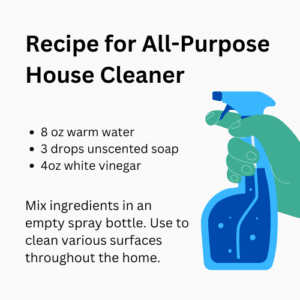Asthma Remediation Resources
More information and helpful resources related to each component of Asthma Remediation services are listed below.

Resources for Asthma Remediation
Asthma Self-Management Education (ASME) Visits
ASME Providers
ASME must be provided by a qualified nonphysician health care professional, such as a certified asthma educator specialist (AE-C), respiratory therapist (RT), or specially trained lay health worker (e.g., health educator, community health worker (CHW), etc.), with documented training and demonstrated competency in delivering guidelines-based asthma self- management education and comprehensive home environmental assessments to identify and provide education on reducing asthma triggers. The NYS Home-Based Asthma Services Training course outlined below under “Recommended Training” is designed to meet these requirements.
Recommended Training
NYS Home-Based Asthma Services (HBAS) Training
The NYS Children’s Asthma Initiative offers a six-module course to support Social Care Network Lead Entities with expanding NY’s workforce of community health workers (CHWs), Asthma Educator Specialists (AE-Cs), home-visiting nurses, health educators, and other partners qualified to provide evidence-based asthma services in the home setting. The NYS HBAS Training offers comprehensive guidelines-based asthma training to HBAS delivery partners statewide with an aim to increase trainee knowledge and competency in delivering asthma self management education (ASME), home environmental trigger assessment, and support for the reduction/remediation of asthma triggers in the home. Trainees receive education on asthma supportive products and home improvement asthma remediation measures and receive a comprehensive toolkit of guidelines-based resources including asthma and home environmental assessments, ASME education tools, and HRSN resources. A certificate of completion from the American Lung Association is provided to trainees satisfying all curriculum requirements.
Use our contact form or email us to express interest in enrolling in the NYS HBAS Training!
Assessment Templates
Assessments for initial and final ASME visits:
Dwelling Assessment & Scope of Work (SOW) Development
Dwelling Assessment
The following resources and recommendations can be used to guide selection of Asthma Remediation Home Improvement HRSN Providers qualified to conduct the Dwelling Assessment (b.1):
- Recommendations for Home Improvement Contractor Qualifications: View Here
- Empower+ Participating Contractors
- County and city home-improvement contractor licensing sites can be accessed on the Office of the NYS Attorney General. Note that home-improvement contractors must be licensed in New York City, Suffolk, Nassau, Westchester, Putnam, and Rockland
counties, and the City of Buffalo. - Building Performance Institute
- Link for contractors to obtain/recertify various certifications
- Find a contractor link
SOW Development
The SOW should outline recommended remediation services, supportive products, and associated pricing and must be approved by the Social Care Navigator.
SOW Technical Review
Each SOW should receive an SOW Technical Review by a qualified reviewer with industry-standard credentials in building science and healthy homes principles working independently of the HRSN service provider performing installation of approved Asthma Remediation measures. Additional information regarding potential organizational partners qualified to conduct the SOW Technical Review will be shared with the SCNs as it becomes available.
Home Remediation and Provision of Supportive Products
Home Improvement Contractor Information
The following resources and recommendations can be used to guide selection of Asthma Remediation Home Improvement HRSN Providers qualified to implement Component C:
- Recommendations for Home Improvement Contractor Qualifications: View Here
- Empower+ Participating Contractors
- County and city home-improvement contractor licensing sites can be accessed on the Office of the NYS Attorney General. Note that home-improvement contractors must be licensed in New York City, Suffolk, Nassau, Westchester, Putnam, and Rockland counties, and the City of Buffalo.
- Building Performance Institute
- Link for contractors to obtain/recertify various certifications
- Find a contractor link
Specialized Remediation Services
- Integrated Pest Management (IPM)
- IPM services should align with the New York City Integrated Pest Management Toolkit
- IPM services including pesticide application must be delivered by professionals licensed by the NYS Department of Environmental Conversation (verification of licensure available at the NYS Department of Environmental Conservation’s Bureau of Pesticides Management
- Find a Pesticide Professional: https://extapps.dec.ny.gov/nyspad/find?12
- Mold Remediation
- NYS Department of Labor Mold Program
- NYC Environmental Protection Mold Abatement
Supportive Products
The ASME provider for component a. can supply asthma supportive products and indoor allergen reduction products and bill associated costs towards the Member’s cap. Supportive products can also be provided under Component C. and should be listed on the completed Scope of Work (SOW) for review and approval by the SCN Technical Reviewer and Social Care Navigator. Allowable supportive products are listed in the SCN Operations Manual and include:
1) Hygrometer
A moisture or humidity gauge (hygrometer) can be provided to measure relative humidity levels indoors. The US Environmental Protection Agency (EPA) recommends that indoor humidity levels remain between 30 and 50 percent. Readings outside of this range may indicate a need for a humidifier or dehumidifier which should be considered only within the context of broader healthy building principles.
- Learn more about humidifiers using this EPA fact sheet: Use and Care of Home Humidifiers.
- Learn more about dehumidifiers using this information sheet from the Department of
Energy: Supplemental Humidity Control for Hot-Humid Climates.
2) Allergen impermeable pillow and mattress encasements
The Asthma and Allergy Foundation of America provides additional information on asthma and allergy friendly covers at https://community.aafa.org/blog/protect-yourself-from-dust-mites-with-asthma-and-allergy-friendly-pillows-and-pillow-covers.
3) Airtight food storage containers
To support an Integrated Pest Management (IPM) plan
4) Asthma Friendly Cleaning Supplies
- Microfiber cleaning cloths
- Green Scrubbers
- Cleaning buckets & spray bottle
- Microfiber mop
- Castille soap
- Cleaning vinegar (with recipe for mixing)
The above items can be provided with education on green cleaning together with the recipe below:

5) Vacuum with (High-Efficiency Particulate Air) HEPA filter and filter replacements
The HEPA filter should be the last filtration stage for a vacuum’s sealed system so that any air drawn into the vacuum must pass through the HEPA filter prior to being released back into the room. A HEPA filter should meet the standard of capturing 99.97% of particles 0.3 microns in size. The US Environmental Protection Agency recommends that a purchaser “ask the manufacturer or retailer whether the machine has been tested to ensure that it achieves the high efficiency required of a HEPA filter.”
6) Air conditioners, dehumidifiers, and air filtration devices
(limited to mechanical only) will be available to Members eligible for Asthma Remediation. These services will be funded under 2.2 Home Remediation Services. Members may be assessed and deemed eligible by a Social Care Navigator for additional services under 2.1 Home Accessibility and Safety Modifications and 2.2 Home Remediation Services, subject to per-Member caps.
Special Considerations
Appliances and supportive products purchased should utilize guidelines established by the Asthma and Allergy Foundation of America’s Asthma & Allergy Friendly® Certification Program and be ENERGY STAR® certified as applicable. Specifications for air purifiers, also called air cleaners, are listed by the California Air Resources Board. Only mechanical air cleaners are allowable because they are efficient at cleaning the air and don’t create any harmful chemicals. Choose the right size air cleaner for the size of the room they will be used in the most. Additional guidance on air cleaners is available from the Regional Asthma Management and Prevention: Air Cleaners for Asthma Programs.
Quality Assurance Inspection
Quality Assurance Inspection
The Quality Assurance Inspection must be conducted by a qualified inspector holding industry-standard credentials in building science and healthy homes principles with expertise to conduct a QA inspection in alignment with Building Performance Institute (BPI) and other industry
technical standards for QA.
BPI Quality Control Inspector Certification
The Home Energy Professional (HEP) Quality Control Inspector certification is offered by BPI and is supported by the U.S. Department of Energy (DOE) and its National Renewable Energy Laboratory (NREL). https://www.bpi.org/certified-professionals/quality-control-inspector/
Additional Resources
NYS Children’s Environmental Health Centers (NYSCHECK): a state-based model for pediatric environmental health services which offers education, screening, consultation, and referrals to needed interventions.
- Locate your regional center at https://nyscheck.org/
New York State Healthy Neighborhoods Program (HNP): NYS funded contracts awarded to local health departments to provide a healthy homes approach to help people with asthma and others achieve better health while also saving money and improving household conditions.
Regional Clean Energy Hubs: The New York State Energy Research and Development Authority (NYSERDA) provides help and information to individuals, small businesses, and affordable housing owners about the benefits of the clean energy economy, ways to reduce energy use and costs, and how to make more informed energy decisions.
- Find your local hub at https://www.nyserda.ny.gov/All-Programs/Regional-Clean-Energy-Hubs
EmPower+ Program: NYSERDA helps low- and moderate-income households save energy and money toward energy improvements made to their primary residence.
NYS Weatherization Assistance Program (WAP): assists eligible renters (non-NYC), homeowners, and rental property owners by reducing heating and cooling costs and addressing home health and safety issues.
- Learn more at https://hcr.ny.gov/weatherization
Additional CHW Training Resources
- Community Health Worker Online Health-Related Courses hosted by MCD Global Health. Module 5 is focused on asthma and is available FREE to CHWs residing in NYS
- Community Health Worker Resources
https://rampasthma.org/get-involved-with-ramp/join-our-networks/community-health-worker-network/
- Minnesota Asthma-Home Based Services Manual and Resources
https://www.health.state.mn.us/diseases/asthma/professionals/home-basedservicestoolkit.html
Learn More About NYHER & Asthma Remediation Offerings
Social Care Networks (SCNs)
Health-Related Social Needs (HRSN) Services
Resources & Training
Questions?
- Inquiries and/or feedback related to NYHER and the Social Care Networks can be emailed to [email protected]
- The American Lung Association is available through the NYS Children’s Asthma Initiative to provide technical assistance related to NYHER’s Asthma Remediation HRSN Services. For more information, use our contact form or email NYSCAI here.
